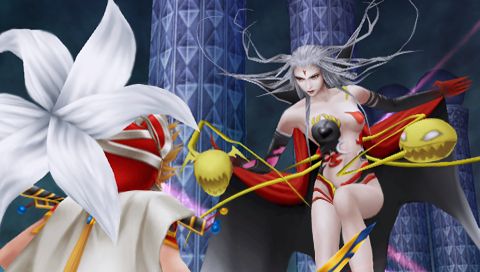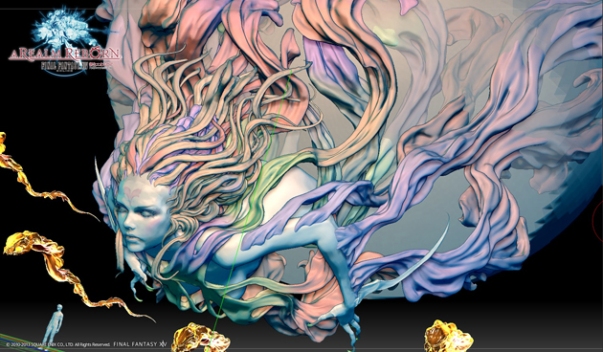Topic of Interest – Final Fantasy III

A light game review by Shuartzu Iakuoy
Continuing on the Topic of Interest series, we now visit the world of Final Fantasy III. For any true fans of the Final Fantasy XIV: A Realm Reborn end-game content, I’d definitely recommend picking this one up!
History:
The production history of this game is definitely an interesting one. By the time of this game’s original debut in Japan (1990) for the Famicom (NES – Nintendo Entertainment System), the Final Fantasy franchise had already won much commercial success in the western markets. Unfortunately, this game had come between console generations as the Super Famicon (SNES – Super Nintendo Entertainment System) was currently in production. It was because of plans to concentrate on the new 16bit gaming scene that any plans for localisation in other countries for this title were sidelined until some 16 years later.
It was because of this need to “catch up” that the series made a jump from the release of Final Fantasy II for the NES in 1988 to the next western release of Final Fantasy III, actually Final Fantasy VI, in 1994. The missing Final Fantasy’s IV and V had since been localised for the western market in the coming years but it wasn’t until the 3D remake that came out on the Nintendo DS in 2006 that this was finally localised.
Since its release in 2006, the remake has since been further released on iOS, Android, PSP and most recently for PC, now also available for download on Steam.
Characters & Story:
The story follows four youths who will eventually becomes known as the Warriors of Light called Luneth, Arc, Ingus and Refia as the come to realise certain truths about the world around them. The initial opening between the two games are very different, with the newer remake allowing for a much deeper character development between the main and supporting cast of characters.
Due to the jumps in technology since the games original release, the remake allowed for more content to be pushed into the game, truly making the game a remake rather than a re-release. Despite all of that, the main storyline stayed true to its original but with a lot more content to appease gamers of the common era of gaming.
The story starts with a very common theme to classical role playing games; the search for crystals. The world has gotten dark and it is up to the four chosen individuals to help seek out the crystals to return light to the world, as it is slowly being engulfed by darkness.
From here, they explore the mysterious floating continent and beyond, eventually chasing down the evil Xande. As the adventurers continue, they realise that is not all they have to face as the realm of darkness slowly seeps through and another threat emerges, the Cloud of Darkness.

“Cloud of Darkness” facing off against the Onion Knight as she appears in “Final Fantasy: Dissidia” (PSP)
Common character Cid as expected makes an appearance. As per usual in the Final Fantasy franchise, the character befits a role relating to airships. He becomes a very important supporting character and is one you’ll see a fair bit of.
You’ll also encounter several guest characters as the plot progresses who psuedo-joins the party in perhaps a fashion similar to that of Odin/Gilgamesh does from Final Fantasy VII (albeit more common) where they will random appear and attack uncontrollably as you adventure around. These guest characters include: Sara, Desch, Cid, Aria, Alus, Unei and Doga. Each of the guest characters will have an important impact on the main playable characters of the game.
Gameplay & Mechanics:
Final Fantasy III introduced a game mechanic not seen again until Final Fantasy VII which allowed the player to choose what role a character would take on. Unlike the previous the original Final Fantasy however, this role was not permanent. More than anything, this is a trait that has not been seen in any other single player Final Fantasy to date but instead has been one of the core mechanics behind the massive multiplayer iterations of the franchise; Final Fantasy XI and Final Fantasy XIV.

A sample of only some of the jobs featured in Final Fantasy III
Starting with a basic “Freelancer” job role, the player is granted additional job roles as the player progressed through the game. Each job would level up separately so that a player may change to suit his or her needs as the game progresses up to the their final job roles. A transitional phase exists whereby characters will carry a debuff to their stats depending on the job and experience of that character to prevent the player from skipping back and forth too much, a necessary component to help maintain balance within the game.
The original job system has since seen many alterations as time has gone on however. “Onion Knight” was originally the starter job (since replaced by “Freelancer” in the remake) and was instead used as a secret job that can be unlocked later in the game.
 Stiltzkin, Final Fantasy IX
Stiltzkin, Final Fantasy IX
For any fans of Final Fantasy IX, the moogle-born MogNet has been carried across. Most likely piggy-backing of the social networking and multiplayer aspects of the internet community, this exists as a method of transmitting messages to other players. This system also allows for some mails to be sent between NPC’s and the main characters.
Other than that, the game adopts the common character experience point system (as skipped in Final Fantasy II) and utilises the standard turn based combat.
Graphics:
In its original form, this game made the most of what was available at the time, far outshining the graphics from it’s two predecessors and was the final Final Fantasy to be original released on the Famicom/NES. Despite all the hard work in it, it’s shame that the original never saw an official release outside of Japan.
 “Final Fantasy III” (NES) |
 “Final Fantasy III” (Nintendo DS) |
In comparison however, the 2006 remake for the Nintendo DS allowed for a much more refreshing makeover. The style of the remake is very reminiscent of that shown in the Final Fantasy: Crystal Chronicles series but still maintained the essence as displayed in its original release.
One thing that both versions had in common is that both releases came out towards the end of the lifetime of the console it was originally released for allowed the game to really push the boundaries and capabilities of that system. The graphics for both games are well defined and are truly spectacular for their times.
Music:
By this point, I honestly don’t know what I can say. At this point, the games were still following a very similar but successful format which included a lot of similarities of the music that was featured.
While many of the games share a lot of themes, perhaps one of this games grandest songs was Legend of the Eternal Wind which could be considered the main theme to the game.
To any players of the end game content of Final Fantasy XIV: A Realm Reborn and in particular to those who have ventured into the Crystal Tower, there are several songs that you should be able to recognise.
Crystal Tower (Final Fantasy III):
Syrcus Tower (Final Fantasy XIV: A Realm Reborn):
Ultimately, this game does not disappoint any who is a fan to the music from Final Fantasy and is just another release from within the true golden age of gaming.
Final & Personal Thoughts:
It took me a long time to make it through this game. About half way through the game, I reached a point where I simply stalled. One of the odd quirks about this game is the surprising rarity of the common item to the Final Fantasy franchise; the Phoenix Down. This common life reviving object is usually buyable from the item shop NPC’s but in this game, there’s a limited amount scattered around as a rare dungeon treasure. Because of this, it’s easy to screw up.

“Cloud of Darkness” as she appears in the official artwork for Final Fantasy XIV: A Realm Reborn,
scheduled to appear in update 2.5.
Once you’re able to push past that though, I found the game to be surprisingly fun and well worth the push. Even though it took me three attempts to get the motivation to complete it, I’m glad I did. It’s by no means the best Final Fantasy but at the same time, it is by no means the worst. At the very least, it’s definitely worth the £10.99 it costs to buy on Steam!
Posted on September 2, 2014, in Orphan Legacy and tagged Orphan Legacy #03. Bookmark the permalink. Leave a comment.
Leave a comment
Comments 0